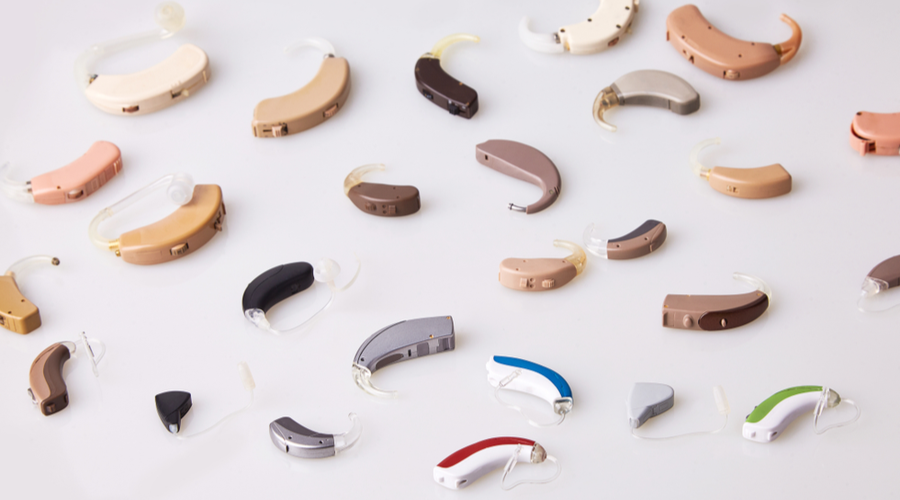Inside: Over-the-counter hearing aids will become available to the public soon. Here’s what independent retail pharmacies need to know.
If you have a bad knee, you simply buy a cane or walker off the shelf of a retailer. If you have minor myopia, you grab a pair of reading glasses off a common revolving kiosk. If you have mild hearing loss, you go to a physician, then to an ear doctor, then to an audiologist, and then you take some tests and are finally fitted for a hearing aid.
That arduous process is one reason only one-fifth of people who would benefit from a hearing aid use one, and why the FDA has issued a landmark proposal to make hearing aids available over the counter. “A big part of it is the complexity of the current pathway,” said Elaine Mormer, an audiologist and professor of Communication Science & Disorders at the University of Pittsburgh. “Walking into a pharmacy and finding something off the shelf will be much better than the current scenario for a lot of people.”
In 2017, the Over-the-Counter (OTC) Hearing Aid Act—part of the FDA Reauthorization Act—required the FDA to develop regulations for a new category of OTC hearing aid. Although the law defined the new category and obligated the FDA to establish regulations, this new FDA rule will finalize regulations and finally make OTC hearings aids available to the public in 2022. This rule means independent retail pharmacies will have new devices to offer in their front end, as well as a new opportunity to care for their patients. According to the National Institute on Deafness and Other Communication Disorders, nearly 30 million U.S. adults could benefit from hearing aids.
“What I’m most excited about is that the pharmacist can now contribute to hearing healthcare, and we can collaboratively work with our audiology colleagues to help get these devices to the people who could benefit,” said Lucas A. Berenbrok, PharmD, associate professor of Pharmacy and Therapeutics at the University of Pittsburgh.
As the most accessible healthcare professional, pharmacists stand in the perfect position to assist the 30 million people who could benefit from this new category of medical devices. “It fits in the whole picture of the pharmacist as a broad front door to health,” Mormer said. “Communication is such a key part to health, for people to get that information about what they should be doing to take care of themselves. Pharmacists can really help keep that channel open.”
Becoming educated in OTC hearing aids
To help prepare pharmacists for this role, Mormer and Berenbrok created an accredited continuing education course that teaches pharmacists how to recognize hearing loss, assess the need for OTC hearing aids, assist in the selection of devices, communicate with patients with hearing loss, and collaborate with audiologists.
“For many people, they just don’t even know where to begin,” Mormer said. “Once people start coming through the door for these hearing aids, they’re going to have a lot of questions.” Mormer and Berenbrok’s CE course (CHAMP-Championing Hearing Using Accessible Medication Experts at the Community Pharmacy)—as well as an additional paper on pharmacist competencies—can train pharmacists to become a trusted resource for patients and open the door to a beneficial, new partnership.
“I always like to emphasize the fact that we really believe in this collaborative approach,” Berenbrok said. “Even though it’s an OTC hearing aid, the pharmacist still has a really great opportunity to not only offer devices to folks with mild-to-moderate hearing loss but also to collaborate with the local audiologists for those who can’t be helped by these devices. So this is a really great way to bring our two professions together.”
How to recognize hearing loss
The proposed OTC rules apply to hearing aids intended for people 18 and older who have perceived mild-to-moderate hearing loss.
The proposed FDA guidelines outline some of the common indicators of mild-to-moderate hearing loss, but pharmacists can help patients validate their need for a hearing aid by recommending a hearing test. Berenbrok said that some pharmacies test the patients in their pharmacy through an online test on a tablet.
In his experience with pharmacy patients, Berenbrok has learned two reliable indicators of hearing loss: continually asking to repeat himself over the phone and leaning in close to hear him in person. Mormer added that patients with hearing loss may look directly at your face while you are talking or have difficulty hearing when there is background noise.
PSAP VS hearing aid
Under the new regulations, companies will need to distinguish between Personal Sound Amplification Products (PSAP) and hearing aids, which are not the same thing. The FDA distinguishes them by “intent.”
PSAPs are intended to amplify sounds for those without hearing loss, and hearing aids are intended to improve hearing for those with hearing loss. Hearing aids are classified as medical devices and are regulated for safety and effectiveness. PSAPs are not.
“Because such PSAPs are regulated as consumer electronics and not medical devices, they may be more variable in terms of product quality compared to hearing aids,” the FDA says. “The FDA does not regulate such PSAPs for safety and effectiveness like we do for hearing aids.”
Selling OTC hearing aids
Before selling OTC hearing aids, Mormer emphasized the importance of understanding the eligibility requirements. Certain criteria exclude people from purchasing aids even though they are sold over the counter.
“There’s a whole host of exclusions for self-care. Understanding those exclusions and how to recognize those conditions is huge,” she said. “Some hearing loss is due to a medical condition that should be medically treated. You don’t want to miss that and have the person buy a hearing aid when they actually have a brain tumor.”
Pharmacists should have a plan for referring patients who don’t qualify for OTC hearing aids. If you haven’t established a relationship with an audiologist, Mormer recommends a website called Find an Audiologist by the American Academy of Audiology that helps start that connection.
It’s important for pharmacists to learn how to communicate with people who have hearing loss. “They need what we call ‘good communication strategies’ to make sure they’re being heard and understood clearly by the patients,” Mormer said. Some of these strategies include making your face visible, reducing background noise, and in some cases using a portable amplifier.
Like with other OTC devices, patients can learn how to use the hearing aid by reading the label and manual. However, pharmacists may serve as a guide for those who need help understanding the instructions or using the product. For example, many hearing aids pair with smartphones for activation, controls, and features, and some older adults may not have a smartphone or may not be adept at using one.
With this being a new market, pharmacies should be vigilant about vetting products before stocking them. “Do some homework and make sure that the company is accurately labeling their product,” Berenbrok said.
Pharmacist competencies
When the Over-the-Counter (OTC) Hearing Aid Act was enacted, Berenbrok and Mormer saw a gap that needed to be filled. “No one in pharmacy was talking about this,” Berenbrok said. “We quickly recognized that we needed to get people aware and educated on what pharmacists could and should do.”
Collaborating with pharmacists, audiologists, hearing aid manufacturers, and other national organizations, Berenbrok and Mormer developed a consensus list of competency statements for pharmacists when assisting a patient seeking OTC hearing aids.
Below are some of the competencies published in “Pharmacist competencies for over-the-counter hearing aids: A Delphi study.” For the full list, find the article in the Journal of the American Pharmacists Association.
COLLECT
Identify medical conditions that can induce or exacerbate hearing loss
Recognize the signs and symptoms of hearing loss
ASSESS
Assess the individual’s need for referral
Describe hearing health care interventions available to persons with hearing loss
PLAN AND IMPLEMENT
Assist patients in the selection of hearing devices by considering the individual’s needs and preferences
Educate patients about features and functions of hearing devices sold at the pharmacy
FOLLOW-UP: MONITOR & EVALUATE
Access manufacturer resources to assist patients with the care and operation of hearing devices sold at the pharmacy
Recommend care and maintenance for hearing devices sold at the pharmacy
COLLABORATE
Collaborate with hearing health care professionals for the purpose of advice and referrals
Describe the audiologist’s scope of practice
COMMUNICATE
Communicate the benefits and limitations of hearing devices sold at the pharmacy
Explain the effects of untreated hearing loss
From the Magazine
This article was published in our quarterly print magazine, which covers relevant topics in greater depth featuring leading experts in the industry. Subscribe to receive the quarterly print issue in your mailbox. All registered independent pharmacies in the U.S. are eligible to receive a free subscription.
More articles from the March 2022 issue:
- Employee Benefits: The Complete Guide for Independent Pharmacies
- This Compounded Drug Has a 50% Profit Margin and Is Changing Lives
- Inspired End Cap Tips From a National Retail Consultant
- Over-the-Counter Hearing Aids: Everything Pharmacies Need to Know
- 8 Pharmacy Services Third Parties Will Pay For
- How to Streamline Workers’ Compensation Claims
- Chronic Care Management Offers High Reimbursement for Low Investment
A Member-Owned Company Serving Independent Pharmacies
PBA Health is dedicated to helping independent pharmacies reach their full potential on the buy-side of their business. Founded and run by pharmacists, PBA Health serves independent pharmacies with group purchasing services, wholesaler contract negotiations, proprietary purchasing tools, and more.
An HDA member, PBA Health operates its own NABP-accredited warehouse with more than 6,000 SKUs, including brands, generics, narcotics CII-CV, cold-storage products, and over-the-counter (OTC) products — offering the lowest prices in the secondary market.












